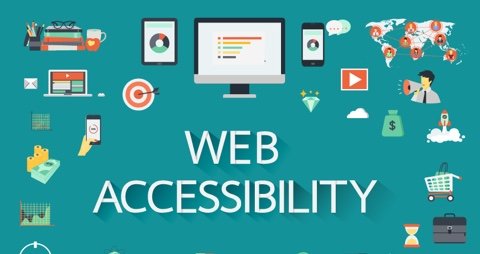Editor's Note: This blog post was updated with additional content and updated statistics for December 2024.
Be honest: have you ever given the importance of website accessibility a second thought? Do you know what some of the basic accessibility features of a website are?
Most people will likely answer no, which we won't say is okay, but it is the current reality of web accessibility—precisely why we'll explain why accessibility is essential.
For many people, accessibility is a part of everyday life. Millions of users with disabilities depend upon accessible designs, devices, and services so they can interact with the world in much the same way a person without disabilities does.
For everybody else, accessibility is a passive experience. We notice accessible ramps and seats but don't engage with them or give them any thought. For people without a disability who don't have a disabled friend or family member, it's very easy to take accessibility for granted, which is probably a safe assumption about most people reading.
As the world becomes increasingly digital, society has adapted in several ways. Whether it's social media becoming a significant component of business strategies or phone apps shoehorning their way into our everyday routines, it goes without saying that digital technology is rapidly changing the way we live and work.
However, lost in all this accelerated change is the fact that the disabled community wants and needs to engage with the digital world just like everybody else. In addition, most people know basic accessibility standards, such as wide doorways, designated seating and parking, and accessible pedestrian signals.
What is Website Accessibility?
When answering the question of what accessibility means for a website, the W3C defines it as "the inclusive practice of removing barriers that prevent interaction with or access to websites by people with disabilities. When sites are correctly designed, developed, and edited according to the web content accessibility guidelines, all users have equal access to information and functionality."
Much like the real world, accessibility on the web is about inclusion. It's about realizing that in the United States, one in five adults has a disability that impacts their use of a standard website. As compassionate human beings, this fact matters because we cannot forget about such a vast number of people – they absolutely need our help to participate in the digital world. And as business owners? Most businesses can't succeed while ignoring a market segment with 53 million potential customers. Implementing web accessibility standards ensures that your website is accessible to all users.
In most cases, we believe businesses don't realize they're excluding users with disabilities. This happens, both because companies don't actively consider accessibility when they develop and execute their digital campaigns and because the issue is sheerly complex. Accessibility in the digital world is hard.
During a webinar on web accessibility, we spoke to Amanda Maisels, a Deputy Chief in the Disability Rights Section of the U.S. Department of Justice. Her insights on accessibility and technology were highly eye-opening, especially her examples of some of the recent enforcement of the Americans with Disabilities Act:
- A settlement with edX, an online education portal that agreed to make its website, platform, and mobile applications accessible to individuals with disabilities
- An agreement with H&R Block in which they consented to make their website, tax filing utility app, and mobile apps fully accessible
- Resolving an issue with Netflix, who agreed to provide captioning for the online video streaming programming
- When a blind customer encountered a point-of-sale system without tactile buttons, making a purchase required them to forfeit their privacy and tell the cashier their credit card PIN number.
The fact that big, well-known brands are struggling to build accessible digital properties is a good indicator of the depth of this issue. Still, there's only one way forward: ask questions, have conversations, and diligently work to raise awareness about web accessibility.
AI and Web Accessibility: Meeting Accessibility Standards for All Users
Incorporating AI into web accessibility allows businesses to proactively address accessibility needs and ensure their websites meet established standards, like those set by the World Wide Web Consortium (W3C). AI-driven tools can assist in detecting accessibility barriers and offer real-time solutions, helping create accessible websites that meet WCAG guidelines. By integrating AI, companies can better support individuals with disabilities, ensuring that digital accessibility includes everyone and fosters an inclusive online experience.
How to Make a Website Accessible
Now that we've highlighted the importance of inclusion, you might wonder how to make a website accessible. Enhancing accessibility involves implementing design and development practices that cater to users of all abilities. By understanding website accessibility principles, you can identify barriers that prevent individuals with disabilities from fully engaging with your content and take steps to remove them.
Here are some practical steps to make your website more accessible:
- Use Semantic HTML: Properly structured HTML helps assistive technologies interpret and present content to users.
- Provide Alternative Text for Images: Alt text allows screen readers to describe images to visually impaired users.
- Ensure Keyboard Accessibility: All website functions should be accessible via keyboard for users who cannot use a mouse.
- Caption Videos and Transcribe Audio: Provide captions for video content and transcripts for audio to aid users with hearing impairments.
- Maintain High Contrast Ratios: Ensure that text stands out against backgrounds for users with visual impairments.
- Implement Responsive Design: Make sure your website adapts to different screen sizes and devices, aiding users who rely on various assistive technologies.
Benefits of Website Accessibility: Enhancing User Experience and Expanding Reach
Embracing the importance of website accessibility offers numerous benefits for both businesses and users. An accessible website ensures equal access to information for users with disabilities, significantly improving the overall user experience. By adhering to the web content accessibility guidelines (WCAG) and established accessibility standards, businesses can reach a broader audience, including people with disabilities. Accessible websites provide a better user experience by being easier to navigate and interact with, regardless of a user's abilities. Additionally, prioritizing accessibility can enhance your search engine rankings, as search engines favor inclusive and user-friendly sites. Ultimately, making your website accessible fosters an inclusive online environment, demonstrating a strong commitment to accessibility and ensuring everyone has equal access to your digital content.
How to Make Your Digital Properties More Broadly Accessible
The first step in making your digital properties more accessible is understanding there is a real issue with accessibility regarding technology and the web. If you're here and you've read this far into the post, you've successfully accomplished the easy part. Now it's time to start making a real difference with your digital properties and, hopefully, help others do so.
But how?
As our other webinar guest, Chris Hofstader, says, "The path to finding remediation for accessibility issues is chaotic." Yet it's because of people like Chris, an active member of the accessibility community and author of what's thought to be the most popular independent blog about blindness and technology, that we even have a path, no matter how chaotic it might seem.
The WC3 and ADA sites are the gold standard for web accessibility information and resources. Although there isn't yet a specific set of web accessibility regulations for businesses, the ADA's general requirements have already been used by courts to demand accessibility compliance from large brands (as we discussed above). In addition, more stringent regulations have been proposed and are coming soon, which gives businesses all the more reason to get familiar with and comply with ADA and WCAG 2.0 standards. Additionally, implementing accessibility features such as alternative text for images and ensuring keyboard accessibility are essential steps in designing and developing accessible websites for people with disabilities. These practices not only enhance the user experience but also ensure content is accessible to all users, regardless of their abilities. By prioritizing accessibility in your web design, you create an accessible website that supports assistive technologies like screen readers, thereby fostering an inclusive online environment for everyone.
As you go forth into 2025 and begin implementing your digital campaigns, always remember to keep the importance of website accessibility in mind, even if they don't directly impact your life!






